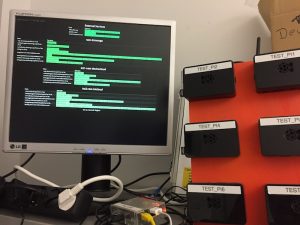 In the early days of the Internet of Things hype, the industry stated that computing power and accessories are cheap and ubiquitous. Read: available and ready to use. The good part of this statement is, that it is true. Partly. RaspberryPi, Arduino, Seed Studio Groove, Adafruit Feather and so on are cheap and versatile computing devices, available on many online retailers. Several toolkits and online resources help the hackers and makers to prototype and develop products. Also many online platforms are ready for the users to connect and manage the things.
In the early days of the Internet of Things hype, the industry stated that computing power and accessories are cheap and ubiquitous. Read: available and ready to use. The good part of this statement is, that it is true. Partly. RaspberryPi, Arduino, Seed Studio Groove, Adafruit Feather and so on are cheap and versatile computing devices, available on many online retailers. Several toolkits and online resources help the hackers and makers to prototype and develop products. Also many online platforms are ready for the users to connect and manage the things.
Nonetheless is the Internet of Things not as ready as the industry states. You can prototype fast, but if you would like to adapt the Internet of Things for your business. If you compare the Gartner Hype Cycle for Emerging Technologies from 2015 and 2016 you may see, that the Internet of Things was dropped. While not sure if intentionally or not, it can’t be found on the plateau of productivity. I would place it in the trough of disillusion. For example, here are some topics, the industry is struggling with.
Product liability (failure, security inside and outside)
A running prototype is good to validate your idea or product improvement. But there is a long way to go until it can be shipped. Especially if the device is integrated into other systems (on the Things side), it must be tested for generating failures in the system. Imagine a device gateway integrated into a vehicle, generating a fault on the bus system which disables the human security systems. Furthermore, especially after the recent hacker attacks, the devices need to be secured for manipulation in all directions, via internet platform into device/system, via device into system and via device into internet platform. This includes physical manipulation as well as networking. But there is help, even for your industry.
Cost of development for world-wide rollout ready solutions
Running a single prototype on a developer board is great, again. But there is a long way to go until it can be shipped globally. If devices are globally distributed, they have to have routines for reset and reconnect, work in situation where network is flaky, slow or even not available sometimes. You need to be able to update devices fast or recover via remote in case of software flaws or security issues. The last thing you want to do is lose control of the devices, let your customers do the work or do it with your workforce.
Business readiness for operating IoT products
Having a nice technical solution is great, again. But does it fit the business case? Are customers willing to pay an additional price or fee? Is the business ready to transform to a pay-as-you-use model, a data-driven business or a B2B2C customer relationship?
Price for connectivity with large number of cheap devices
Even if prototyping hardware is cheap, connectivity is still not. At least mobile connectivity. Ethernet and Wifi are cheaper, but you have to struggle with NAT routing, firewalls and network policies. Mobile network is Plug&Play, with a good provider even worldwide. But a GSM module is at least around 20$ and additional a data plan is necessary. If the Internet of Things product is a low cost device, the connectivity cost don’t fit the business case.
Connecting to legacy machines
In the manufacturing industry and maybe in further industries as well, products are used over 5-10 years. Innovation cycles are longer than elsewhere in the tech industry. There is a huge area of legacy systems to be retro-fitted. It is possible to connect to these systems if there is an interface to use (e.g. RS232/485, Modbus, CAN-bus). Anyway, these systems are not designed to be connected to the internet. Developers need to do expensive try-error-loops and workarounds.
Conclusion
As you can see, there are hurdles to take until an Internet of Things product is ready to launch. This is why I think, despite the statement of cheap hardware, is in the plateau of disillusion. The good news are, there are partners with broad experience in each of the examples. You should select them (carefully), but let help you to solve your problems.
